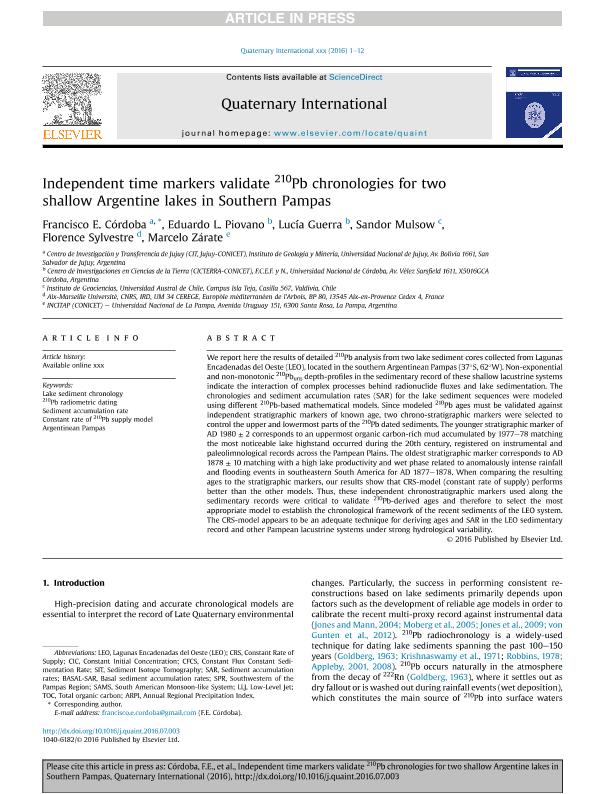Mostrar el registro sencillo del ítem
dc.contributor.author
Cordoba, Francisco Elizalde

dc.contributor.author
Piovano, Eduardo Luis

dc.contributor.author
Guerra, Lucía

dc.contributor.author
Mulsow, Sandor
dc.contributor.author
Sylvestre, Florence

dc.contributor.author
Zárate, Marcelo Arístides

dc.date.available
2018-05-03T17:28:18Z
dc.date.issued
2016-08
dc.identifier.citation
Cordoba, Francisco Elizalde; Piovano, Eduardo Luis; Guerra, Lucía; Mulsow, Sandor; Sylvestre, Florence; et al.; Independent time markers validate Pb-210 chronologies for two shallow Argentine lakes in Southern Pampas; Pergamon-Elsevier Science Ltd; Quaternary International; 438; 8-2016; 175-186
dc.identifier.issn
1040-6182
dc.identifier.uri
http://hdl.handle.net/11336/43995
dc.description.abstract
We report here the results of detailed 210Pb analysis from two lake sediment cores collected from Lagunas Encadenadas del Oeste (LEO), located in the southern Argentinean Pampas (37°S, 62°W). Non-exponential and non-monotonic 210Pbuns depth-profiles in the sedimentary record of these shallow lacustrine systems indicate the interaction of complex processes behind radionuclide fluxes and lake sedimentation. The chronologies and sediment accumulation rates (SAR) for the lake sediment sequences were modeled using different 210Pb-based mathematical models. Since modeled 210Pb ages must be validated against independent stratigraphic markers of known age, two chrono-stratigraphic markers were selected to control the upper and lowermost parts of the 210Pb dated sediments. The younger stratigraphic marker of AD 1980 ± 2 corresponds to an uppermost organic carbon-rich mud accumulated by 1977–78 matching the most noticeable lake highstand occurred during the 20th century, registered on instrumental and paleolimnological records across the Pampean Plains. The oldest stratigraphic marker corresponds to AD 1878 ± 10 matching with a high lake productivity and wet phase related to anomalously intense rainfall and flooding events in southeastern South America for AD 1877–1878. When comparing the resulting ages to the stratigraphic markers, our results show that CRS-model (constant rate of supply) performs better than the other models. Thus, these independent chronostratigraphic markers used along the sedimentary records were critical to validate 210Pb-derived ages and therefore to select the most appropriate model to establish the chronological framework of the recent sediments of the LEO system. The CRS-model appears to be an adequate technique for deriving ages and SAR in the LEO sedimentary record and other Pampean lacustrine systems under strong hydrological variability.
dc.format
application/pdf
dc.language.iso
eng
dc.publisher
Pergamon-Elsevier Science Ltd

dc.rights
info:eu-repo/semantics/openAccess
dc.rights.uri
https://creativecommons.org/licenses/by-nc-sa/2.5/ar/
dc.subject
210PB RADIOMETRIC DATING
dc.subject
ARGENTINEAN PAMPAS
dc.subject
CONSTANT RATE OF 210PB SUPPLY MODEL
dc.subject
LAKE SEDIMENT CHRONOLOGY
dc.subject
SEDIMENT ACCUMULATION RATE
dc.subject.classification
Meteorología y Ciencias Atmosféricas

dc.subject.classification
Ciencias de la Tierra y relacionadas con el Medio Ambiente

dc.subject.classification
CIENCIAS NATURALES Y EXACTAS

dc.title
Independent time markers validate Pb-210 chronologies for two shallow Argentine lakes in Southern Pampas
dc.type
info:eu-repo/semantics/article
dc.type
info:ar-repo/semantics/artículo
dc.type
info:eu-repo/semantics/publishedVersion
dc.date.updated
2018-05-02T17:39:22Z
dc.journal.volume
438
dc.journal.pagination
175-186
dc.journal.pais
Estados Unidos

dc.description.fil
Fil: Cordoba, Francisco Elizalde. Consejo Nacional de Investigaciones Científicas y Técnicas. Centro de Investigaciones y Transferencia de Jujuy. Universidad Nacional de Jujuy. Centro de Investigaciones y Transferencia de Jujuy; Argentina
dc.description.fil
Fil: Piovano, Eduardo Luis. Consejo Nacional de Investigaciones Científicas y Técnicas. Centro Científico Tecnológico Conicet - Córdoba. Centro de Investigaciones en Ciencias de la Tierra. Universidad Nacional de Córdoba. Facultad de Ciencias Exactas Físicas y Naturales. Centro de Investigaciones en Ciencias de la Tierra; Argentina
dc.description.fil
Fil: Guerra, Lucía. Consejo Nacional de Investigaciones Científicas y Técnicas. Centro Científico Tecnológico Conicet - Córdoba. Centro de Investigaciones en Ciencias de la Tierra. Universidad Nacional de Córdoba. Facultad de Ciencias Exactas Físicas y Naturales. Centro de Investigaciones en Ciencias de la Tierra; Argentina
dc.description.fil
Fil: Mulsow, Sandor. Universidad Austral de Chile; Chile
dc.description.fil
Fil: Sylvestre, Florence. Centre National de la Recherche Scientifique; Francia
dc.description.fil
Fil: Zárate, Marcelo Arístides. Consejo Nacional de Investigaciones Científicas y Técnicas. Instituto de Ciencias de la Tierra y Ambientales de La Pampa. Universidad Nacional de La Pampa. Facultad de Ciencias Exactas y Naturales. Instituto de Ciencias de la Tierra y Ambientales de La Pampa; Argentina
dc.journal.title
Quaternary International

dc.relation.alternativeid
info:eu-repo/semantics/altIdentifier/url/http://www.sciencedirect.com/science/article/pii/S1040618215302172
dc.relation.alternativeid
info:eu-repo/semantics/altIdentifier/doi/http://dx.doi.org/10.1016/j.quaint.2016.07.003
Archivos asociados
